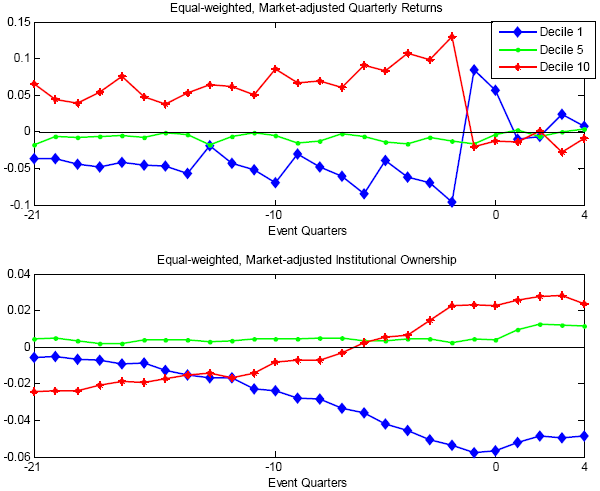What causes the value premium, a rational risk factor or an irrational overreaction? If the latter, who overreacts and to what? In his February 2007 paper entitled “Institutional Investors, Intangible Information and the Book-to-Market Effect”, Hao Jiang investigates a connection between the value premium and the trading behavior of institutional investors. Specifically, he tests whether institutions overreact to intangible information (that not derived directly from firm accounting measures). Using data on returns, accounting fundamentals and institutional ownership encompassing 49,164 firm-years over the period 1981-2004, he concludes that:
- Both the level and the number of institutional holdings in a stock relate positively to past (intangible) returns unattributable to accounting fundamentals.
- Both past intangible returns and institutional ownership relate significantly and negatively to future stock returns. A zero-cost portfolio that is long (short) stocks with low (high) past intangible returns generates an annual alpha of 7.7%. It appears that the intangible information causes changes in institutional ownership, and not vice versa.
- A reasonable interpretation is that institutional investors tend to overreact by buying (selling) stocks in herds in response to positive (negative) intangible information. Rather than correcting the overreaction of others, they make it worse.
- Extreme intangible returns are most likely in the information technology and pharmaceutical industries, perhaps representing investor optimism regarding vague or ambiguous growth opportunities. Such returns relate positively to high R&D expenditures, trading volume, return volatility and dispersion in analyst earnings forecasts.
The following charts, taken from the paper, relate the behaviors of intangible stock returns and institutional traders.
The top chart plots equal-weighted, market-adjusted quarterly returns on portfolios of stocks with very low (Decile 1), intermediate (Decile 5) and very high (Decile 10) intangible returns over the past five years. As shown, very high past intangible returns translate to quarterly market outperformance of 5-15%. About two quarters before portfolio formation, the abnormal performance of stocks with very high and low past intangible returns disappears or reverses.
The bottom chart plots equal-weighted, market-adjusted institutional ownership of these portfolios over the same period. It shows that institutions gradually accumulate (dispose of) stocks with past high (low) intangible returns.

In summary, institutional herding on hope and fear drives overvaluation (undervaluation) of growth (value) stocks, leading to their future reversals of fortune.